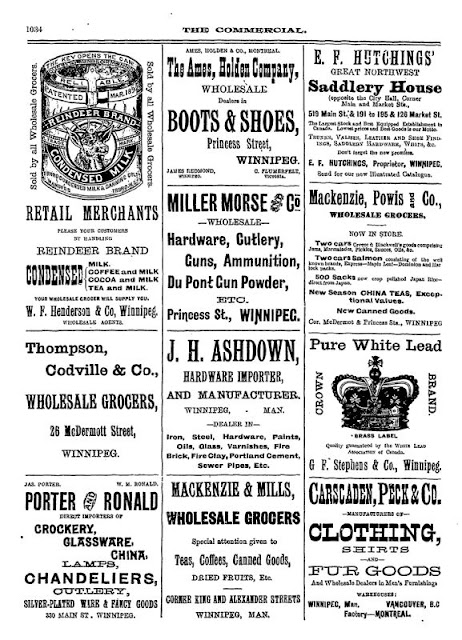Records for your ancestor's personal life are the back bone of genealogy research. Looking into their professional life can be harder. If they were in public service, such as law or politics, there are many sources that are a matter of public record. Business owning ancestors don't leave as much behind. Of course, if your connection is to the Christies, Redpaths, Molsons, Bombardiers, or Ganongs, then no problem. These iconic Canadian business families have mention everywhere. But what if your ancestor was a smaller business owner? If they lived in Manitoba in the late 1800's, then you should look through the pages of The Commercial. You can find over 1000 issues on Canadiana. Geared toward business owners, they stated that they were "A journal devoted to the financial, mercantile and manufacturing interests of the Canadian North-west."
The journal ran from 1882 to 1922. Canadiana has issues up to 1903. The main body of the journal is filled with articles that talk about market trends and news of interest to business and industry owners. It was a fore runner to industry magazines you see today like Canadian Business Magazine. They may not be the most interesting reading for someone not in, say, the business of selling farm machinery. But, these articles can give you an insight into the working world of your ancestor. These outside factors can tell you why they changed careers, sold their business, or why their business prospered when others didn't. For instance, there is a rather scathing article admonishing The Montreal Witness. The article basically says that their opinions on the quality of Manitoba crops is doing harm.
Another feature of the journal was snippets throughout about specific companies. In the very first issue, you can see that there was a huge fire at a HBC mill, and several changes in ownership of companies.
The journal focuses mainly on Manitoba, and Winnipeg in particular. However, other parts of Canada do get mention now and then. Here's an example from 1895 of Assiniboia and Saskatchewan.
Here's mention of Alberta in 1902.
Lastly, any publication needs advertisement revenue. If your ancestor was a business owner, don't over look the advertisement pages. They made have placed an ad. I think they're interesting to look at regardless, but I'm a genealogist and we're a special breed. Here's some from 1893
Here's some examples from 1889
And finally, some from 1903. Notice the one for lead paint in the bottom left.
Canadiana lets you download whole issues by clicking on the PDF icon next to the "+" sign.
Alternatively, you can right click on the image and save a single page.
As you can see above, you can also search keywords within a document. I used dry goods" and it told me which pages I could find that phrase. Just click on the page number and it will take you to that page. Keep in mind though that the keywords won't be highlighted.

























